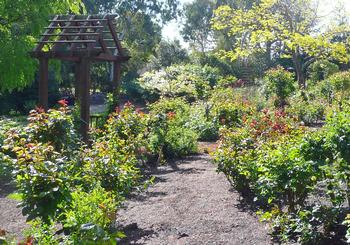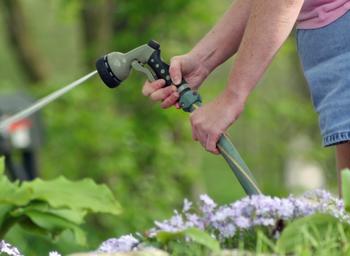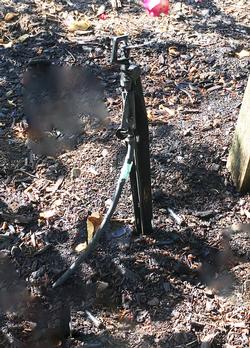Keep your roses healthy during drought
-
Nanette Londeree
-
Drought is a scary thing and we’re in one. This past winter was one of the driest in local history and now we’re all grappling with mandatory water cutbacks. How do you care for your beloved roses under these circumstances? While the queen of flowers performs best with ample water, they can make it on much less. The plant may not grow much and produce puny, if any, flowers this summer as they basically go dormant, but they will survive.
 Soil covered with a layer of mulch retains moisture while suppressing weeds. Photo: Nanette Londeree
Soil covered with a layer of mulch retains moisture while suppressing weeds. Photo: Nanette LondereeHow much water a rose plant needs depends on many things - the age, size, and location of the plant, the type of soil it is growing in and the air temperature, humidity, and wind conditions. Many gardeners water plants frequently for short amounts of time. This encourages development of shallow roots, so plants have a tougher time when water is cut back, often wilting or exhibiting leaves with brown, dead edges. But it’s not how they start out. Modern rose suppliers grow plants in production fields located in super-hot areas like Bakersfield, California and Phoenix, Arizona. They are deeply watered only once per week (furrow irrigation for about half a day), no matter if the temperatures are in the triple digit range for weeks. And they do just fine.
To maximize your water use and keep your roses healthy, consider:
Smaller may be better: Trim plants back significantly to reduce their overall size. The more foliage on the plant, the more water it will require to keep the plant healthy. You’ll lose some summer bloom, but come fall with its cooler temperatures, you’ll likely get another crop of flowers.
Leave the leaves: Whether cutting roses for bouquets or removing spent blooms, leave as much foliage on the plant as you can. While the leaves do require water to stay hydrated, they are the cooling system for the plant, and provide shade for the base of the plant which can help reduce moisture loss from the soil. When watering with a hose, have an on/off valve at the use end and shut the water off when moving between plants. Photo: Pixabay
When watering with a hose, have an on/off valve at the use end and shut the water off when moving between plants. Photo: PixabayForget the fertilizer: Actively growing plants need more water. Give the plants a rest through the hot summer months (July – September). Keep them watered but avoid anything that stimulates growth. If you must fertilize, use an organic material like fish emulsion, that releases nutrients slowly into the soil.
Check your tools: Confirm that whatever tools you use to water your roses are in good working order. Fix leaky hoses or faucets; check drip irrigation, sprinkler systems, and timing devices regularly to ensure proper operation. If you water by hand using a hose, have an on / off valve at the use end and shut the water off when moving between plants.
Timing is important: Water during the early morning hours when temperatures and wind speed are the lowest and stretch the number of days between waterings. Roses do best when 50% of available water is used up between irrigations. Don’t water based on the calendar or a schedule, watch the weather, your plants, and monitor the moisture in the soil.
Technique makes a difference: Water your plants slowly and deeply; apply water only as rapidly as the soil can absorb it. When possible, divide watering cycles into shorter periods to reduce runoff and allow for better absorption every time you water. Apply water within the “drip line” of the plant (that imaginary line from the outermost leaves of a plant down to the soil) Drip irrigation using micro-sprayers is a good way to apply water slowly and deeply. Photo: Nanette Londeree
Drip irrigation using micro-sprayers is a good way to apply water slowly and deeply. Photo: Nanette LondereeMulch, mulch, mulch: Add a layer of mulch to the soil to moderate soil temperature, reduce evaporation, and reduce weeds. Remove weeds first, then carefully spread an even layer of mulch over the soil surface (two to four inches), keeping it a few inches away from the base of the plant.
With a little planning and extra care, you can keep your roses alive while reducing your overall water use. Then come next season, after a winter of “normal” rainfall (we hope), they’ll be ready to perform once more.



